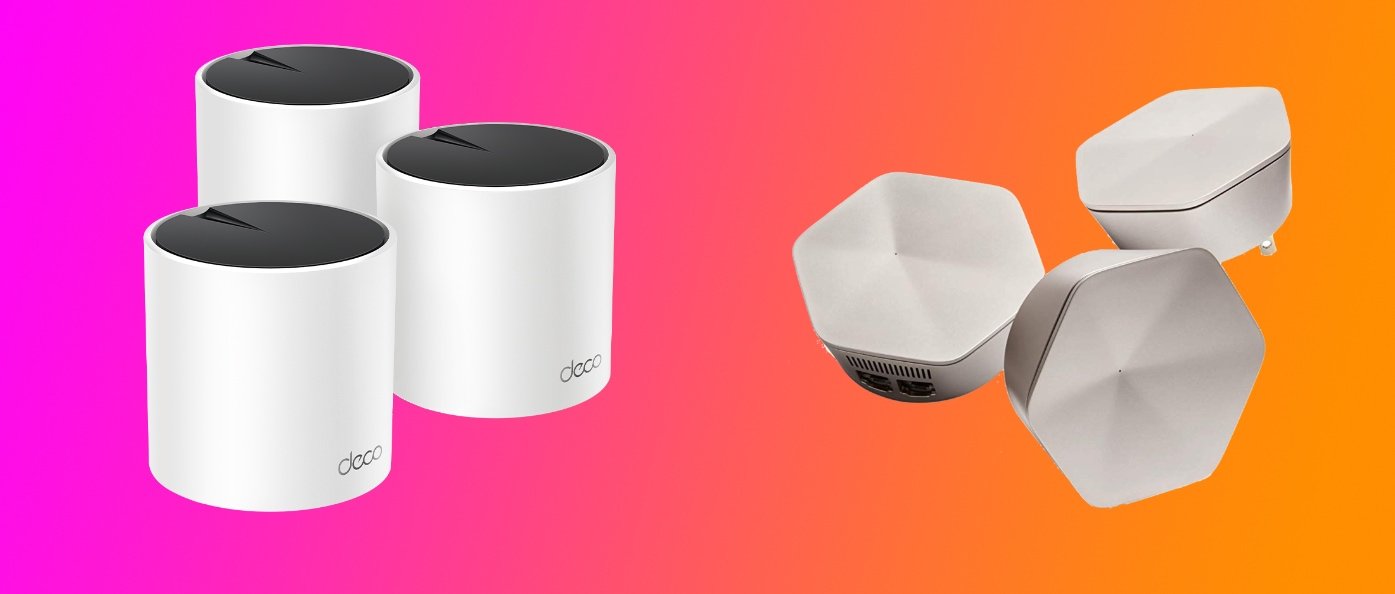Plume SuperPods vs TP-Link Deco: Head to head test results
I’m breaking from my usual topics of privacy and user experience. Today: Wi-Fi mesh showdown! Let’s see how my three-year-old Plume SuperPod network did vs a new TP-Link Deco X55 network.
Note: Originally published March 2023, but updated March 2024 based on Plume business changes. See final paragraphs.
Why did I do this at all?
The Story So Far… (Jump to the next section if you just want the test info.)
A few weeks back, we had a power outage – a common experience in our part of Massachusetts. (Thanks for nothing, 90’s utilities deregulation fad and two decades of underfunded grid maintenance.) Afterwards, our Plume wi-fi network never came back online. I tried some basic troubleshooting, then called Plume. I ended up on hold for an hour, then the call dropped. I opened a support ticket on my phone, along with some angry comments. And then I started researching a replacement mesh network.
I consulted with nerdy friends, and decided to try TP-Link’s Deco mesh Wi-Fi system. I ordered a three unit set of Deco X55’s.
Meanwhile, Plume got back to me, then quickly assigned an L2 tech support rep. Fabian actually read my notes (this is uncommon in my tech support experiences), expressed sympathy with my frustration, and helped identify a hardware failure in the gateway SuperPod.
I told Fabian I was also testing the TP-Link Deco hardware. And to my surprise, he noted that the newer Wi-Fi 6 hardware might give better results than Plume, and encouraged me to try it out. I was floored by this candor. Not just anyone would be willing to suggest trying a competitor's product.
One of Plume’s service managers also reached out to me; he was alarmed at the 1-hour wait time I had reported. He was able to find my call in the logs; their computer system somehow placed me on infinite hold instead of transferring me to a human. (Later in this story, when I called, I never waited more than a minute to talk to a human.)
Well, Fabian’s confidence in Plume was well-placed. In my testing, my three-year old SuperPods performed far better than the brand-new Wi-Fi 6 TP-Link Deco network.
Thanks to great support from Fabian and the my Wi-Fi test results, I'm not giving up on Plume after all. I plan to renew my Plume subscription next month. I did not expect this. It shows that the measure of a company (or a person) isn’t that a mistake was made, but how they deal with it.
What and How I Tested
Sampling and hardware
Sampled at 7 key locations where we use WiFi in my house. For the active network scan, in some rooms I tested in several spots where we tend to sit, and averaged them. In two rooms I kept the data separate – each of our desk locations and my kids’ bunk bed. (Yes, I know this is not entirely consistent, but it fits my needs.)
Each Wi-Fi network’s gateway was also set up as the router for my LAN, connected to Comcast on one side and a consumer-grade gigabit switch on the other
Wireless client was a MacBook Air M1 (with Wi-Fi 6)
Gigabit wired ethernet client was a Mac Mini M2 Pro, which hosted an iperf3 server. Wi-Fi was disabled, but Bluetooth was active.
Test tools
Local network latency – simple ICMP ping time from wireless client to router, 10 pings, 1 sec delay
ping -c10 -W 1 <router IP address>
Internet latency – TCP latency as measured by Testmy.net to Google's cloud
Averaged the results of 3 runs for each location in my house
Throughput – iperf3 from wireless client (Wi-Fi 6 Macbook Air M1) to gigabit ethernet client (Mac Mini M2 Pro)
Wi-Fi Site Survey by Netspot – www.netspotapp.com
Passive: Signal-to-noise, signal level, signal-to-interference, noise, freq. band coverage, download speed, upload speed, nominal wireless transmit rate
Active: iperf3 TCP upload & download (local network), upload & download (to netspot's server)
Start with the data, please
Table: TCP latency, local ping times, and max throughput
Visualization 1: Signal-to-Noise Maps
In general, the signal-to-noise ratio roughly corresponds to the user experience of a Wi-Fi network.
Visualization 2: Signal Strength Maps
Signal level, in my experience, corresponds less to UX than SNR, but does still matter. A weak signal is a weak signal.
Visualization 3: TCP Download Speed Maps
TCP download speed, as measured by iperf3 to an Ethernet-connected local server.
Findings
The Deco network's local network ping times averaged 40% higher than Plume's (Deco 24ms, Plume 17ms), and had a much higher standard deviation.
The Deco network's internet TCP latency was 75% higher than Plume's (Deco 91ms, Plume 52ms). Deviation was three to four times larger as well. (This could be just variations in Comcast, but I saw this difference across several different days.) The Plume network lagged only 8–12ms behind the wired network, and showed similar very low deviation as well. (Boom goes the dynamite!)
The Deco network's throughput also underperformed. On local-only transfers (via iperf3), Deco averaged 228 Mbps down and 182 Mbps up, compared with Plume's 386 Mbps down and 315 Mbps up. (That makes Plume 70% faster down, and 73% faster up.) I also saw similar difference on the Internet up/down tests to Netspot's server, but those vary so much depending on Comcast that I do not set much store by them.
The Deco network's wireless transmit rate averaged 20% faster than Plume's. But as the latency and throughput data shows, that didn't translate into any advantage I could see.
Discussion
The Plume SuperPod network has far better latency and throughput than the TP-Link Deco X55 network.
The TP-Link Deco X55 is probably limited by being dual-band (vs Plume’s standard Tri-band radios). The more expensive TP-Link's tri-band Deco AP’s would probably fare somewhat better, but I don't think it would be a decisive advantage. I saw enough variation in Deco performance that I suspect TP-Link's software is the limiting factor, not the number of available radios.
You might think this test is unfair, because the Deco network had only 3 APs, vs the Plume’s 5 APs. But TP-Link claims its 3 AP kit should cover 6500 square feet, while Plume recommends 5 or 6 to cover my house. In other words: I am using the products as recommended by their makers.
I can think of easy ways to help the Deco network perform better:
At least one base station was in a poor spot, and would have done better in the Dining room. But I didn’t want to install new wall shelving or wall mounts, or run extension cords across the room.
Connecting the AP’s by Ethernet would improve backhaul immensely. I don’t want to fish Ethernet through the walls to them. Plus, the same problem of appropriate furniture or mounting applies.
Plume’s tiny pods that plug into any power outlet allow me to have much better coverage than the Deco X55 large base stations, which need a safe surface to sit on.
Managing the networks
In an ideal world, you plug in your network and forget about it.
Here in reality, some Wi-Fi devices are bad clients. Exhibit A is the Nintendo Switch. It sticks like glue to the first access point it connects to, then stays there, no matter how terrible the signal.
The Deco management app lets me force clients to re-associate to APs, which is useful for badly behaved clients like this. Plume’s app has no such tool, so I have no idea if it is aggressive at forcing bad clients to re-associate. I have noticed it takes days for many wireless clients to de-associate with the first SuperPod that comes up on the network. (Rule #1 of networking: if it ain’t broke…)
Deco has a lot of settings I can mess with – such as disabling beamforming, disabling mesh mode, and QoS – but almost none of them are actually going to make the wireless network better. Yet Deco's designers have chosen not to expose more advanced network settings such as static routes and network-wide VPN tunneling. The result is a system which is just complex enough to get into trouble, but not capable enough for prosumers. At least, for me.
Plume’s HomePass app doesn’t expose lots of options. It’s very Apple-like in that they want it to just work. Unfortunately, this can mean it’s harder to troubleshoot when something goes wrong. (Also very Apple-like.) It does let me establish time- and access-restrictions, multiple guest networks, map ports to internal hosts, set DCHP reservations, and monitor security events. No static routes or whole-network VPN, but I guess I can’t have everything.
The verdict
TP-Link’s marketing claims are big. But they don’t deliver.
2402 Mbps! Nope. Even when across the room with a clear line of sight to the base station, I never saw a wireless link rate higher than 980 Mbps, and even that lofty speed had lower actual performance than Plume.
WiFi Dead Zone Killer! Not really. I still had very low-performing zones.
Oh, and “Comprehensive Reports” and “Advanced Security” and “IoT Protection”? Not without a subscription. So much for “no subscription” claims. At that point, I’ve lost any advantages I might get by dropping Plume’s subscription – which at least they are up front and honest about!
The Deco X55 didn’t meet its claims, and was out-performed by hardware designed in 2018. I’d like to see how their tri-band hardware performs, but the high variability in performance makes me think the issues here are software, not hardware, and might be shared by the tri-band products. (If anyone wants to loan me some Deco tri-band hardware, feel free.)
Plume support came through
When the chips were down, Plume came through for me. I’m not an influencer or prolific blogger or YouTuber. I’m just an ordinary retail customer. And they still put in time and effort to support me. Thanks, Fabian and Jeff.
And as I found in testing, even though the SuperPod is an older hardware design, it still beats new products from the competition. It’s worth the price.
I had reservations, but now I don’t
When I first wrote this a year ago, Plume had shifted from focusing on the retail customer to ISP partnerships. It’s a more reliable revenue stream for them. It’s got to be hard to compete with Eero, which is an Amazon brand that gets top billing on Amazon. (Amazon has shown it’s happy to lose money for years to drive competitors out of a market.)
But the shift left me feeling like I’m not a customer they care about. After all, I’m a few bucks a year in revenue, not a few million. Am I the product, or the customer?
My conversations with their support manager were somewhat encouraging, at least insofar as it showed me that some people in Plume cared about the consumer market. But I wasn’t convinced.
But now, a year later, they have re-balanced, giving home users, small business, and ISPs an equal footing. They’ve resumed spending marketing money on the original core business, and have been releasing new features like Network Boost squarely aimed at consumers, not ISPs.
My future with Plume isn’t at risk like it seemed last year. The people at Plume care, and it remains a truly great product. Plume Wi-Fi has super performance and it just works. I’m comfortable recommending Plume again. If you need a good WiFi network, give it a look at plume.com.









